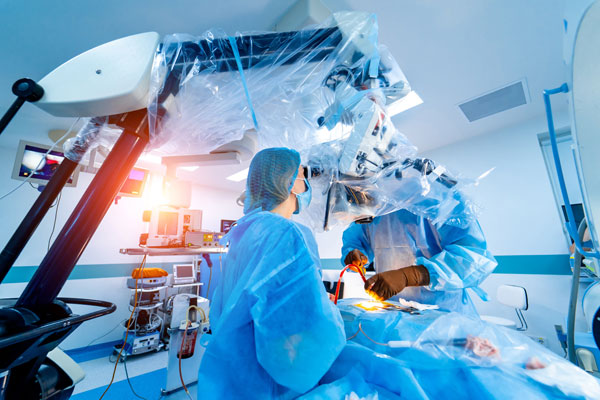CH Baktawar Singh Rd, Medicity, Islampur Colony, Sector 38, Gurugram, Haryana 122001
29 June, 2023

Myasthenia Gravis (MG) is a rare autoimmune disease that affects the neuromuscular junction, causing muscle weakness and fatigue. While there is no known cure for MG, there are several treatment options available to manage the symptoms and improve patients’ quality of life. One such option is surgery, which can be performed using traditional open techniques or minimally invasive robotic techniques.
In recent years, minimally invasive robotic techniques have gained popularity in many areas of medicine due to their numerous benefits over traditional open surgery. In this article, we will explore the advantages of using minimally invasive robotic techniques for Myasthenia Gravis patients undergoing surgery and how it can significantly improve their outcomes.
Traditional surgical techniques for Myasthenia Gravis (MG) primarily involve thymectomy, which is the removal of the thymus gland. While thymectomy can be an effective treatment option for MG, there are certain limitations and risks associated with traditional surgical approaches. Here are some of the key considerations:
Incomplete thymus removal: In traditional thymectomy, the thymus gland is removed through a surgical incision in the chest (transsternal approach) or through the neck (transcervical approach). However, complete removal of the thymus can be challenging, and there is a risk of leaving behind thymic tissue or microscopic remnants. This can result in incomplete treatment and potential disease recurrence.
Invasive surgery and associated complications: Traditional thymectomy techniques involve open surgery, which requires a larger incision and may involve spreading of the ribs or sternum. This can lead to longer hospital stays, increased pain, and a higher risk of complications such as infection, bleeding, damage to surrounding structures, and longer recovery time.
Scarring and cosmetic concerns: Open surgical approaches can leave visible scars on the neck or chest, which might be a cosmetic concern for many people.
Limited accessibility for certain patients: Traditional thymectomy techniques may not be suitable for all patients, particularly those who are older or have underlying health conditions that make them high-risk candidates for surgery.
Delayed therapeutic effect: It can take several months to years for the full benefits of thymectomy to be realized, as the immune system may take time to readjust and symptoms may persist for some time after surgery.
It’s important to note that advancements have been made in thymectomy techniques, including minimally invasive approaches such as video-assisted thoracoscopic surgery (VATS) or robotic-assisted surgery. These techniques aim to address some of the limitations associated with traditional surgical techniques, offering smaller incisions, reduced pain, shorter hospital stays, and faster recovery times. However, the suitability of these approaches depends on the patient’s specific condition and the expertise of the surgical team.
It is advisable for individuals with MG to consult with a specialized healthcare professional, such as a neurologist or thoracic surgeon experienced in MG management, to discuss the potential benefits, risks, and limitations of various surgical approaches and determine the most appropriate treatment plan for their individual case.
Minimally invasive robotic techniques are becoming an increasingly popular alternative to traditional surgeries. These procedures utilize advanced robotics technology, allowing physicians to perform surgical procedures through smaller incisions with greater accuracy and precision.
These surgeries have revolutionized various surgical procedures, including those for conditions like Myasthenia Gravis (MG). Here’s an overview of robotic techniques and some of their benefits:
Robotic-assisted surgery: Robotic surgery involves the use of a surgical robot system, such as the da Vinci Surgical System, which consists of robotic arms controlled by a surgeon from a console. The robotic arms hold and manipulate surgical instruments with precision, mimicking the movements of the surgeon’s hands.
Enhanced precision and dexterity: Robotic systems offer greater precision and dexterity compared to traditional surgical techniques. The robotic arms have a wider range of motion, allowing for more precise movements during surgery. This enhanced precision can be particularly advantageous in delicate procedures, such as thymectomy, where the removal of the thymus gland needs to be performed carefully.
Improved visualization: Robotic surgery provides high-definition, magnified 3D visualization of the surgical site. This allows the surgeon to see intricate details with greater clarity, enhancing their ability to identify and preserve vital structures while performing surgery.
Smaller incisions: Robotic techniques enable the use of smaller incisions compared to traditional open surgery. The surgical instruments used in robotic-assisted surgery are slender and can be inserted through tiny incisions. These smaller incisions result in less tissue trauma, reduced scarring, and potentially faster recovery times.
Reduced blood loss and complications: The precise movements and improved visualization in robotic surgery can contribute to reduced blood loss during the procedure. Additionally, the minimally invasive nature of robotic techniques may lead to a lower risk of complications such as infection, postoperative pain, and hospital-acquired conditions.
Shorter hospital stays and faster recovery: Robotic-assisted surgery is associated with shorter hospital stays compared to traditional open surgery. The reduced tissue trauma, decreased pain, and quicker postoperative recovery can allow patients to return to their normal activities faster.
Potential for improved outcomes: Although the long-term benefits of robotic-assisted thymectomy for MG are still being studied, early evidence suggests that robotic techniques may offer comparable or improved outcomes compared to traditional approaches, including higher rates of complete thymus removal.
It’s important to note that not all patients with MG may be suitable candidates for robotic surgery, and the decision to undergo robotic-assisted surgery should be made in consultation with a specialized healthcare professional like Dr. Harsh Vardhan Puri, who is one of the best lung surgeons in Delhi. The surgeon’s expertise and experience in robotic procedures, as well as the availability of robotic systems in the healthcare facility, are also important factors to consider.
Overall, minimally invasive robotic techniques have the potential to enhance surgical precision, reduce complications, and improve patient outcomes in the treatment of Myasthenia Gravis and other conditions.
Category : Myasthenia Gravis